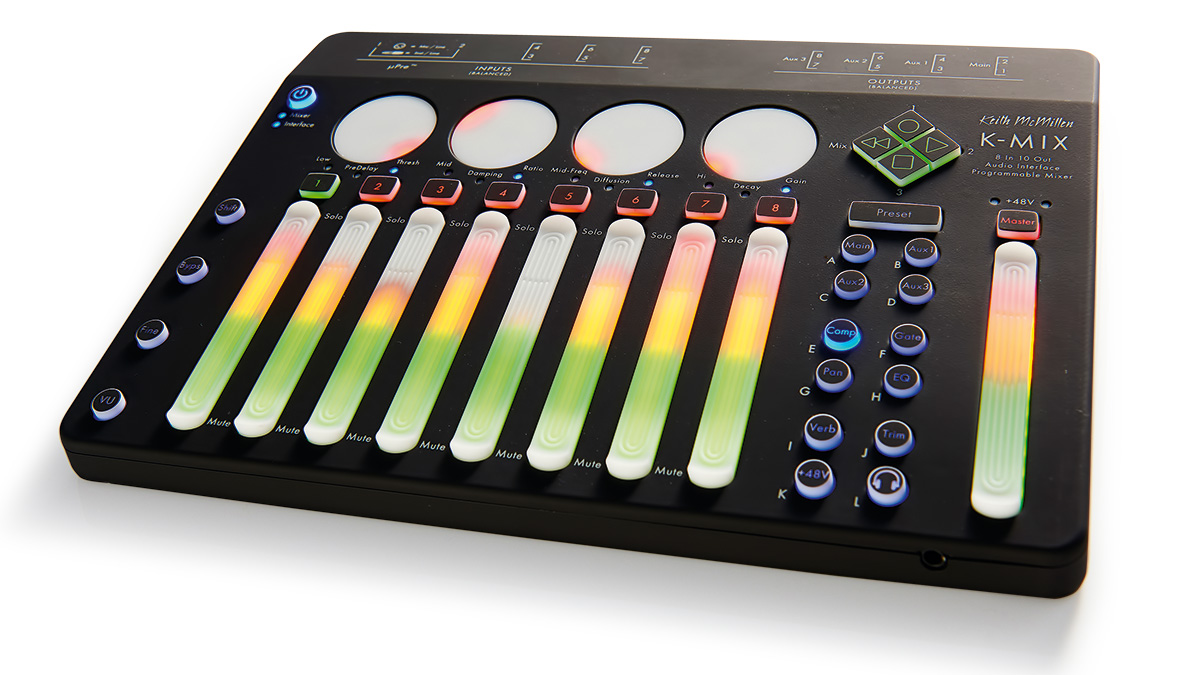MusicRadar Verdict
An impressive, affordable solution for those seeking audio interfacing, mixing and control functionality.
Pros
- +
An excellent all-rounder.
Cons
- -
Tiny writing for each command.
MusicRadar's got your back
Keith McMillen has helped design products including Akai's MPX820 and MB76, the Mirror 6 MIDI Guitar, the QuNeo 3D, and the QuNexus and K-Board keyboards.
His aim is to provide flexible tools for modern musicians and the K-Mix sets out the blueprint, offering audio interfacing, mixing and control surface manipulation in one compact unit. With no moving parts in the design, K-Mix has been constructed to withstand the bumps of both studio and live requirements.
Starting with its audio interface, K-Mix provides eight balanced inputs and ten outputs, including the stereo headphone output. Channels 1 and 2 are set up for line or microphone connections, while channels 3-8 are for line and phone input sources only.
Physical connections are made on the rear panel, with power provided via an external PSU and connection to your computer is made via a separate USB. Phantom power, for the mic inputs, is available on channels 1 and 2.
All aspects of a channel's configuration can be handled from the front panel, with Fader level adjustment of the interface controllable once you've pressed the 'Main' button. Then, to adjust levels for each of the eight channels, you can let your fingers slide up and down the rubberised faders for each channel, with LED backlights showing you values for each fader in turn, turning from green, through yellow to red at the upper end.
To adjust input Trim for each channel, there's an equivalent Trim button, so pressing this allows you to set input levels. In the same way, via dedicated buttons for each section, you can enable or disable phantom power for channels 1 and 2, engage Pan positions for each channel, enable per-channel three-band EQ, configure auxiliary sends and access the global reverb effects send, which is mixed into the main stereo output.
The rotary dials above the faders are 'multi-function', depending on the task in hand. When EQing, they control individual bands from bass on the left to treble on the right. When using Compression, they control Threshold, Ratio, Release and Output gain with other modes assigning them alternative tasks.
As each mode button is pressed, a red LED inside each of these rotaries glows to show its current position, while blue LEDs toggle from the controls of one function to the next, so you can always see what you're doing. The writing printed next to each command is small and hard to read in low light settings but it doesn't take long before you're reaching for specific commands intuitively.
Setting up the control capabilities of K-Mix will vary, depending on your chosen DAW, but once you're connected, you can 'teach' your host software K-Mix's control options, which are extensive. Again, faders and rotary pots make obvious partners to key DAW features but other buttons (with the exceptions of Power and Shift) can be configured to transmit control data too.
K-Mix manages to squeeze an awful lot into its frame and there's much more here than immediately meets the eye. If you're on the lookout for a hybrid audio interface, control surface and mixing environment, K-Mix offers all of the above at an attractive price point.
GAK is gone: UK music store giant GAK just got bought by Gear4Music for £2.4 million
“It pretty much half killed us. Whether the band would continue was in the balance”: The Radiohead album that almost broke up the band, turned the music industry on its head - and became their best record
“It is ingrained with my artwork, an art piece that I had done years ago called Sunburst”: Serj Tankian and the Gibson Custom Shop team up for limited edition signature Foundations Les Paul Modern










